|
||||||||||||
|
|

|
||||||||||||
|
|
Yes indeed, My Diabetic Soul – An Autobiography remains available on Audible .com through ACX.Com. My reading it to you, my voice, has been recorded through ACX to successfully and easily bring this pleasurable audio book to you – and your ears.
Here is the link: https://www.amzon.com/My-Diabetic-Soul-An-Autobiography/dp/B07JZH2MXC/ref=tmm_aud_title_0?_encoding=UTF8&qid=&sr=
It is my voice that you will hear. Here is a snippet….
What do you think?
If you were to imagine this in a movie, whom would you choose for the characters? There’s me as a child, my mother whom I would choose to be played by Julia Roberts; my father whom I would choose to be played by George Clooney; three sisters and a brother. A few more are mentioned in the book as you will learn, including numerous doctors. But how would you visualize this?
I’d love to hear from you. Thanks! A. K. Buckroth (#buckroth)

Yes, an astounding 50-Year celebration with the few people that have lived courageously and successfully with diabetes. By ‘few,’ I mean approximately 6,153 since 1970. 1970. Phew. That’s six thousand, one hundred and fifty three individual characters in 50 years.
Absolutely awesome!
Having been a recipient of this particular medal in 2010, I am glad to report that I have lived another 10 years with diabetes. Let me tell you…it has not been easy. Whew. In order for me to receive a 75-year medal, self-discipline is a nurtured core value.
Without further ado, I leave you with the latest Joslin Medalist Newsletter, Spring 2019. Enjoy! A. K. Buckroth #buckroth Amazon.com Facebook LinkdIn 🙂
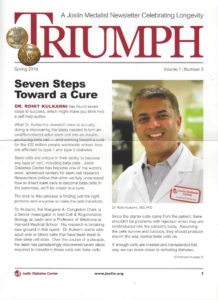
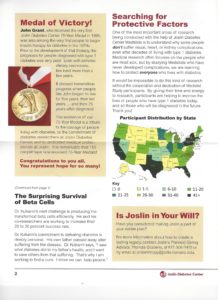
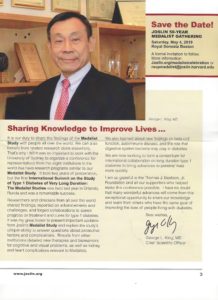
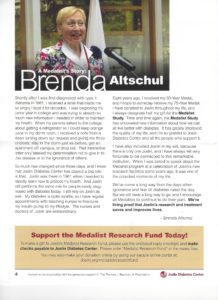
TODAY! March 27, 2019… “#KNOWSURVIVETHRIVE…KNOW the facts, SURVIVE the impact, THRIVE live the life! THIS WEDNESDAY General Richard Roth will present #Senate Bill 138 at the State Capitol. #BretMichaels will be testifying as to why #SB138 is crucial in raising awareness and #educating the public through our #California school districts. Come show your support! March 27th at 9:00 a.m. in the John L. Burton Hearing Room (4203). We hope to see you there! Please share! Thank you. – Team Bret🤘🏻#Unbroken #SingerSongwriter JDRF”
Read about it here: http://leginfo.legislature.ca.gov/fac…/billTextClient.xhtml
Appropriate to post here: 10 Things teachers should know about having a student with Type One Diabetes http://www,GetDuabetesRight.org
An insulin pump isn’t a cure
It is hard to have diabetes,even when I have an insulin pump. My blood sugars will vary every day and there is no such thing as “control” with Type 1. Please be patient while I deal with low and high blood sugars.
I wear super cool gadgets that help keep me alive.
My insulin pump and/or continuous glucose monitor may look like the latest ipod or mobile phone – some alarms even sound like a ring tone. Please don’t take them away from me – you would be putting my health in danger.
Sometimes I need to eat in class I need to keep glucose tabs and snacks in my desk (or pockets) in case of emergency.
If go low, even a trip to the nurse’s office could be too risky without immediate fast acting sugar, I may not be brave enough to speak up for myself.
I depend on you to put my health and well being first. It’s not always easy to speak up when I’m low or high and need to take care of diabetes. It helps to know you’re looking out for my best interests.
I need immediate attention when I tell you I feel low, I may also need your help. Please give me a snack or let me check my blood sugar immediately.
Don’t leave me alone or send me to the nurse’s office by myself. My body and brain won’t be functioning properly and I could make a wrong turn or collapse in the hallway. I also cannot finish a test or complete my work until I have treated my low.
When my blood sugar is high, I use the restroom frequently.
This will not change, no matter how old I get. Please be patient when I need to take multiple restroom breaks throughout the day. This typically means my blood sugar is high and my body is reacting normally to flush extra glucose.
When my blood sugar is high, I also need to drink more to help it go down.
Please don’t call me diabetic because I am defined by WHO I am, not by diabetes.
If I’m not listening well or following instructions, I may need to check my blood sugar.
Please don’t assume that my lack of obedience or cooperation has anything to do with my attitude.
If you notice I’m not paying attention or am acting odd, gently ask me to check my blood sugar.
Thank you for being patient with interruptions in class.
Checking blood sugar multiple times a day, adjusting insulin levels and treating lows or highs can be exhausting.
Your compassion during these interruptions will help make school easier for me so that I don’t feel like a burden to you or the class.
Some days are a roller coaster of highs and lows.
Days that include low and high blood sugars happen. And when they do, I may feel terrible. It’s similar to how you feel when you have the flu or have had too much alcohol.
#buckroth 🙂
Diabetes currently affects 30.3 million Americans. That’s nearly one in ten!
The odds that either you or someone you love suffers from diabetes are alarming. It can be a difficult disease to handle, especially along your travels. Whether you’re a diabetic with an ambitious bucket list or you’re traveling with a diabetic who needs your care, we’ll give you the need-to-know for your upcoming domestic travels.
Just like anything else, each situation is very different and should be handled on an individual basis. Not all of these tips will apply to everyone with diabetes. After all, there are different types of the condition:
Here are some tips to exercise in preparation for and during your travels on how to manage diabetes.
Your diabetes shouldn’t control your urge to travel!
With finding cheap flights, reserving the best hotels, mapping out activities, and planning finances, it’s difficult enough to construct the perfect trip WITHOUT worrying about diabetes. Managing your diabetes or your loved one’s diabetes can make it that much more overwhelming. A few of my family members have diabetes, and we’ve learned to construct our vacation plans around meals.
But there are ways to quiet your stress and amplify your excitement for your adventure.
One cardinal step you can take to prepare for your trip is to research pharmacies in the area you plan to visit. That way you’re not scrambling for the best options during an emergency!
It’s true that we’re living in a non-paperwork era. But nothing can ever replace a proper doctor’s note.
This is especially applicable to seniors and children traveling alone. However, it can’t hurt to have a conversation with your doctor about any recommendations they would give for traveling with diabetes. You might have questions such as:
Be sure to get the doctor’s appointment well ahead of time so there is no last-minute rush. You should also have a written prescription on your person. If you are carrying syringes and/or insulin, it is important to carry documentation that the medication is for you specifically.
Diabetes is considered a disability, so it is always a good idea to have documentation. And to be doubly prepared, keep in mind airport policies & accessibility options around the country. Here is a quick sample of airport wheelchair policies & accessibility options from a few of the busier airports in the United States:
| Airport | Accessible Restrooms | Handicap Parking | Wheelchair Service |
| Hartsfield-Jackson Atlanta International Airport (ATL) | All restroom facilities are fully equipped for wheelchair access. Four sets of “Men/Women” restrooms are located on each concourse. One set is located at either end, and two sets are centrally located on each concourse. Two sets are in the Airport’s Domestic Terminal atrium, including one set in the arrival’s lobby. Additional restrooms are located at the International Terminal, with a set on both the departure and arrival levels. Unisex family restrooms for those traveling with an attendant are located throughout the Airport: Domestic terminal arrival’s lobby (2) T2, T4, T8 and T12 A6 and A27 B9, B23 and B27 C15, C18 and C37 D4 and D32 F4, F6, F9, F12 Concourse F mezzanine level, departure level and arrival level An adult changing table is located in the family bathroom at Concourse F departure level near French Meadow Cafe. | Parking for passengers with disabilities is available in all Airport parking areas. Once you enter the parking lot, just follow the signs to the designated parking spaces, which are closest to the Airport’s terminals. Passengers with disabilities are encouraged to use the Airport “Park-Ride” facility, which offers convenient service to the domestic terminal. A free, wheelchair-accessible shuttle bus will pick up passengers at their vehicle and take them to curbside check-in. Vans taller than 8 feet should park in “Park-Ride” lots. Upon returning to Hartsfield-Jackson, “Park-Ride” customers are picked up at the ground transportation area. “Park-Ride” parking rates are $1 per hour and $9 per day. For additional information, contact ABM-Lanier-Hunt 24 hours a day at (404) 530-6725. | Airline representatives are available to provide wheelchair assistance. To reserve a wheelchair, contact the airline directly before your scheduled flight. Passengers with limited English proficiency should contact their airline for language assistance. Due to partial closures on the North Terminal roadways, passengers who need wheelchair assistance for drop-off between 9 p.m. and 5 a.m. should contact their airline’s wheelchair company at least five minutes before arriving at the Airport. Prime Flight (Air Canada, Alaska, American, Contour, Spirit and Turkish) – 404-530-7049 Prospect (JetBlue, Southwest and United) – 404-209-0503 |
| John F. Kennedy International Airport (JFK) | Each terminal has at least one wheelchair accessible restroom. If you need assistance locating one, just ask at the information booth located on the Arrivals Level in any of the terminals. | The terminals and parking lots at JFK are divided into five areas, each specified by a separate color. For your convenience, the parking lots nearest the terminal entrances have a limited number of spaces for travelers with disabilities. To park in the spaces, official license plates issued by a municipality or state of residence must be prominently displayed. Parking fees for these vehicles are equal to the lowest rate available at the airport. | Contact your airline prior to travel for wheelchairs. If you’re traveling with a motorized wheelchair, please ask the airline when you purchase the ticket about their policies regarding battery-operated wheelchairs. |
| Los Angeles International Airport (LAX) | Each terminal has at least one wheelchair accessible restroom. | All parking facilities have designated handicap parking stalls. | Requesting a Wheelchair To Request wheelchair service, it is recommended you contact your airline 72 hours in advance. Wheelchair service is provide free of charge by your airline. Tipping is not required for wheelchair service. Most individuals requesting wheelchair assistance are transported via wheelchair from ticketing to their aircraft. Airlines are required to provide curbside wheelchair service when requested. On your return flight, you should remind a flight attendant near the end of your flight, that you will need a wheelchair upon arrival. Curbside Each airline is responsible for providing wheelchairs for their customers with disabilities, from curbside drop-off to the aircraft. Contact your airline’s reservation desk a minimum of 72 hours prior to your flight to reserve wheelchair service. Wheelchair service is provided free of charge. Tipping is not required. From Parking Structure Airlines are not responsible for providing wheelchair service from parking structures to terminals. |
| Phoenix Sky Harbor International Airport (PHX) | Each terminal has at least one family restroom with a private area to change clothing or disposable undergarments. Ask for directions at any information desk. | Accessible parking is available in all garages closest to the elevators. In the East Economy lot, accessible parking is available north of the PHX Sky Train Station. In the West Economy Park & Walk, accessible parking is available at the east end closest to Terminal 2. If you need extra time at the curb, Airport staff on the curb may issue Special Needs permits. Over height or oversize parking is available in the uncovered economy parking areas and Oversized Vehicle parking area east of Terminal 4. | Request a wheelchair when checking in and tell a flight attendant during the flight. If you are departing, you may request a wheelchair from a Sky Cap at the curb or from a Sky Cap or the airline on the ticketing level of the terminal. You can also request wheelchair service ahead of time when you book your tickets with your airline. Ask your airline about traveling with power chair batteries. |
| San Francisco International Airport (SFO) | Companion Care Restrooms for travelers needing companion assistance are located in all terminals, pre-security and post-security. | All airport parking facilities have convenient parking for vehicles displaying a: DP (Disabled Person) license plate DV (Disabled Veteran) license plate Disabled Parking placard The Domestic Garage has standard parking at all levels. Van accessible parking is available through ParkVALET on Level 4 Departures near Terminal 1, Boarding Area C. International Garages A and G have standard and van accessible parking at all levels. In Long-Term Parking, accessible parking spaces for standard and van accessible vehicles are located on the first (ground) floor. SFO’s Long-Term Parking shuttle buses are wheelchair accessible. | Travelers requiring wheelchair assistance are encouraged to advise their airline of their needs when making flight arrangements. Upon arriving at the airport, travelers with wheelchair or other special requests should approach an airline representative for assistance. At Domestic Terminals 1, 2, and 3, airline staff can be approached at curbside and check-in areas. At the International Terminal, please proceed to your airline’s assigned counter or dial 1-6210 from specially marked phones at all terminal entry doors. Arrangements for assistance to and from other locations at SFO can be made with your airline. |
Contact your airline customer service for further questions and assistance while traveling with someone with diabetes.
As you are traveling, be sure to consider time zones.
Because we are all prone to some level of jet lag, this can significantly affect daily routines, including eating and time of insulin injections. If you don’t establish a schedule, your travels can be railroaded quickly with the potential fluctuation of blood sugar levels.
Jet lag can foil your idea of a good time – especially if your rigid schedule as a diabetic is compromised
It’s vital to carry healthy snacks in case you or your travel buddy are running on low blood sugar. We all practice irregular eating habits while we travel, whether it be indulging in unhealthy food, drinking more than normal, or not getting enough water.
Eating out at a diabetes-friendly establishment isn’t always cheap, so bring and use your favorite restaurant rewards card to get the best bang for your buck for food. It’s a nice way to get a return for money you’d spend anyway.
You can also take control of your diet by packing your own food, including items you know are diabetes friendly, like:
It’s good to mix a few non-perishables in there to ensure you’ve ALWAYS got sustenance in your back pocket. This can be the difference between an enjoyable adventure or an unfortunate trip to the hospital.
Just as you go to the doctor’s for a check-up prior to a vacation, take your car for a check-up, too!
If you are planning to head out for a road trip, be sure to take your vehicle in for an inspection at least a week before you hit the highway. If there’s something wrong with your vehicle, you are giving yourself a few buffer days between a potential problem and your vacation.
However, do consider renting a car. Sometimes it makes sense to pay for a rental car and put the miles on a vehicle that’s not your own. And if you do decide to rent a car, be sure to explore all of your options when it comes to using rewards cards for car rentals. Along with that, be sure to use cards that will give you the biggest return on gas purchases.
If you’ve got room, consider bringing extra medical supplies and snacks. If you’re making a long drive through parts of the country where medical access isn’t readily available, you’re obviously going to want as many fallback solutions as you can get. Bring enough food to account for low blood sugar, and pack a cooler for insulin in case you are traveling through high temperatures (not directly on ice, though!).
Lastly, driving can be extremely tiring. Whether you are driving or not, being cooped up a car for hours on end is taxing. Taking frequent breaks will allow everyone to stretch to keep blood flow moving and prevent fatigue.
While traveling by air is a bit more luxurious, it can still be hard on your body.
If you decide that flying is your best mode of travel, be sure to let the appropriate people know (for example, your flight attendant while you’re boarding the plane). That way they’ll understand when you press the call button and request a cup of juice to stave off hypoglycemia.
This is particularly wise if you’re traveling alone.
In the same vein, you can even use a TSA notification card that will make your airport security process a little less of a headache.
Also, consider bringing medical necessities in your carry-on bag instead of putting them into your checked bag. Do this for a few reasons:
In fact, because airlines allow you 1 personal item (separate from your carry-on), you may want to bring a dedicated diabetes pouch filled with snacks, insulin, and tablets.
Personal items are considerably smaller than carry-on bags, but you can still cram plenty of necessities in there!
And don’t scrimp on the amount of snacks and medicine – bring WAY more than you imagine you’ll need! Remember, diabetics don’t have to abide by the 3.4-ounces-of-liquids rule like everyone else when going through airport security.
To keep your comfort levels up, consider entering airport lounges to rest up and have access to snacks and drinks before your flight. This is my all-time favorite travel accessory.
Airport lounge access isn’t as expensive as you might imagine, especially if you have the right credit card! If you are anticipating a long flight, it could make a world of difference. Many lounges have hot meals, free beverages, high-speed Wi-Fi, private bathrooms, and even showers!
Just like anything else in life, preparation is key to ensure a smooth and enjoyable experience. If you or someone you are traveling with is diabetic, taking steps ahead of time could save you from a potentially health-threatening situation.
Diabetes shouldn’t stop you from seeing the world! See: www.diabetesforecast.org for details.
The last 25 years of my life, I have had to use a BASAL/24 Hour Long Acting Insulin along with a before Meal-Time/Fast Acting Insulin. This is most, but not inherently, due to wearing an insulin pump.
The 35 years before that, I used syringes twice a day. I am dependent on insulin. I am an insulin addict.
The following guide and charts will be of good use to you, the T1D and or T2Ds in need of insulin.
Please use this with your doctor(s).
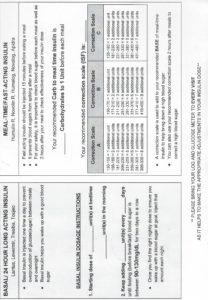
Posted on facebook February 15, 2019, “Judge Denies Insulin Makers’ Motion to Dismiss Class-Action Lawsuit Regarding Skyrocketing Insulin Prices,” this article is definitely worthy here at Buckroth’s Blog.
“Attorney representing individuals living with diabetes against the pharma defendants says judge’s opinion “blows the insulin racket wide open” to expose deals with PBMs.”
“NEWARK, N.J. – Today, a federal judge’s opinion has greenlighted a national class-action lawsuit filed against Sanofi, Novo Nordisk and Eli Lilly for their systematic overpricing of insulin and concealment of a behind-the-scenes arrangement orchestrated to hike insulin prices, according to attorneys at Hagens Berman.
“Hon. Brian R. Martinotti, U.S. District Judge for the District of New Jersey granted in part and denied in part the drug companies’ motion to dismiss the case. The opinion allows state law claims from plaintiffs – people living with diabetes who Eli Lilly, Sanofi and Novo Nordisk have forced to pay skyrocketing insulin prices – and gave attorneys representing them ability to address concerns regarding individual state representation. To the extent the court requires a patient from each state, attorneys say they can and will add clients to satisfy the court’s concerns.
F”ind out more about the lawsuit and sign up.
Regarding the plaintiffs’ state claims, Judge Martinotti’s opinion read, “This Court finds Plaintiffs have adequately alleged fraudulent, unfair, or unconscionable conduct.” The court also held that the plaintiffs “adequately pled an ascertainable loss.”
“The lawsuit states that in recent years, Sanofi, Novo Nordisk and Eli Lilly have raised the sticker or “benchmark” prices on their drugs by more than 150 percent. Some plaintiffs now pay almost $900 dollars per month just to obtain the drugs they need, according to the firm.
“Hagens Berman filed the first-of-its-kind lawsuit in 2017, detailing several accounts from patients resorting to extreme measures to survive rising insulin prices, including starving themselves to control their blood sugars, under-dosing their insulin, and taking expired insulin. The complaint also detailed how class members having intentionally allowed themselves to slip into diabetic ketoacidosis – a potentially fatal blood syndrome caused by lack of insulin in the body – so that they can obtain insulin samples from hospital emergency rooms.
“Steve Berman, managing partner and co-founder of Hagens Berman, was named co-lead counsel in the case by Judge Martinotti.
“In general we are pleased with the decision because we can now bring consumer protection claims in most states,” Berman said. “This ruling also clears the way for us to begin obtaining discovery from the manufacturers and PBMs so we can shine the light on exactly what has driven insulin prices sky high.”
“This ruling blows the insulin racket wide open,” he added.
“The complaint states that this once affordable drug is now out of reach for many patients due to a behind-the-scenes quid pro quo arrangement between drug makers and pharmacy benefit managers (PBMs): “increased benchmark prices are the result of a scheme and enterprise among each defendant and several bulk drug distributors. In this scheme, the defendant drug companies set two different prices for their insulin treatments: a publicly-reported, benchmark price and a lower, real price that they offer to certain bulk drug distributors.”
“Are you Affected? Sign up for the Case Now.
“About Hagens Berman Hagens Berman Sobol Shapiro LLP is a consumer-rights class-action law firm with 10 offices across the country. The firm’s tenacious drive for plaintiffs’ rights has earned it numerous national accolades, awards and titles of “Most Feared Plaintiff’s Firm,” and MVPs and Trailblazers of class-action law. More about the law firm and its successes can be found at www.hbsslaw.com. Follow the firm for updates and news at @ClassActionLaw.”
Media Contact: Ashley Klann, ashleyk@hbsslaw.com, 206-268-9363
Let me explain….
My Diabetic Soul – An Autobiography copyright 2010, remains a good read for those of you that have a copy. As it was originally published through an Indie Publisher, typos in this original version had not been addressed – until now.
Only available for sale as an audio version, read by the author, your quick download via Audible.com is efficient and sufficiant.

My Diabetic Soul – An Autobiography Revised Edition copyright 2018, has taken its place. Its plot and setting are not too different from the original. However, this book holds recent updates with diabetes care, has a delightfully useful Index along with Internet Reference Resources from research. This latest version not only has a bright, colorful title cover, it is crisper to read with available and comfortable inner space. It has been profesisonally copyedited and proofread. Shorter Chapters with new Titles increase clarity and voice through the story. It is also proudly included in the Library of Congress under #2018961888.
After numerous months of efforts, it is available through Amazon.com in paperback and e-book formats. The Nook by Barnes & Noble carries the e-book format, of course.
ISBN- 13; 9781492839682 and ISBN- 10; 149283968X; it is 324 pages, 45 Chapters, with photos.
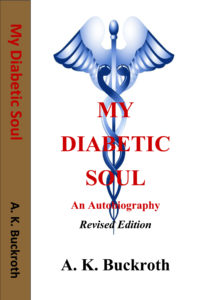
I just wanted to let you know.
Best regards,
A. K. Buckroth (#buckroth)
“Half of the estimated 100 million people worldwide who need insulin do not have reliable, affordable access to the medication that keeps them alive. The three largest manufacturers of insulin — Eli Lilly, Novo Nordisk, and Sanofi — control 96% of the global market volume. Right now, there is no competitive biosimilar market to drive prices down. The lack of competition has resulted in price increases, intensifying the life-threatening issue of access to insulin both in the United States and abroad.
“So how much does it actually cost to produce insulin? And if a truly competitive market existed, how much could insulin cost per person?
“Researchers from Imperial College London, the Harvard TH Chan School of Public Health, and Liverpool University set out to answer these questions with support from the ACCISS study, aiming to improve access to insulin globally. A recent study estimated the price tag associated with creating regular human insulin, analog insulin and their biosimilars.
“Biosimilars are insulins designed to work similarly to an insulin product that already exists and has previously been licensed. This allows for lower costs of research and development, streamlined governmental and regulatory approvals, and ideally lower costs for the product.
“Few biosimilar insulin products have come to market in the United States. In some instances, current insulin manufacturers have taken active steps to prevent new biosimilars from coming to market. For more on this, read “Where are all the generic insulins hiding?”.
“With an active, competitive biosimilar market, this study estimated a reasonable price for analog insulins to be between $78-130 USD per person per year (except insulin Detemir, which was higher). Regular and NPH was even lower — between $48-72 USD per year. Yearly costs are based on an average dosage of 40 units per day (a World Health Organization statistic).
“The numbers proposed take into account not only manufacturing costs, but many of the other variables involved in production including the cost of active pharmaceutical ingredients, cost of other ingredients, cost of vials, cost of transportation, operating expenses and the added cost of bringing a new biosimilar to market. These numbers are “competitive but profitable” to manufacturers based on experts’ analysis.
“This study makes suggestions in the context of government procurement of insulin directly from an insulin manufacturer. The numbers should be interpreted as a price point for what a government might expect to pay per person per year if they were negotiating a dollar amount directly with an insulin biosimilar manufacturer.
“Right now, there is no competitive biosimilar insulin market. Not just in the United States – anywhere in the world. This study sites the insulin oligopoly, regulatory challenges and regular incremental developments in insulin as three reasons we haven’t seen the emergence of a healthy biosimilar market. In order for the low prices suggested here to become a reality, multiple new manufacturing competitors need to enter the ring.
“Not only are the big three insulin manufacturers financially opposed to biosimilars entering the market, they’ve actively taken legal steps to prevent it. In July 2017, Merck received FDA approval for Lusduna Nexvue, a biosimilar of Lantus. It has not launched in the United States because of an outstanding lawsuit — Sanofi, maker of Lantus, sued Merck for patent infringement. Just this month, Merck announced that Lusduna will not come to market because of the cost associated with getting it there.
“The answer to why you’re paying so much for insulin depends on where you live, what kind of insurance you have, and a slew of other variables. The study’s authors remind us: “final prices to patients or health systems may include additional mark-ups added during the supply chain. These mark-ups will vary between countries, as they may be subject to local negotiations, regulations, and other factors. In some cases, these additional markups can be very large.”
“The United States is one such case. For the majority of Americans, the insulin prices we see are not negotiated by the government but by a long list of supply-chain players. Private insurance companies, pharmacies, and pharmacy benefit managers all have a hand in negotiations that impact the list price of insulin set by the manufacturer.
“The $1200 price tag a patient in the United States might see for a month’s worth of insulin reflects the total of money exchanged throughout the supply chain. Exactly how much profit each cog in the insulin-pricing machine rakes in is unclear. Between insulin manufacturers and customers, insulin passes through wholesalers, pharmacy benefit managers (PBMs), pharmacies, and insurance companies. The lack of transparency at every level makes it nearly impossible to understand the scope of the problem. Read more about the insulin-pricing machine here.
“Rising costs are taking a more serious toll than ever because patients are increasingly paying the entirety of the massive price tag out of pocket every month. Health insurance plan design has changed — more people are being forced to pay full prices for the first several months of the year after switching to a high-deductible plan. That is, of course, if they are lucky enough to be insured at all.
“These numbers put in sharp relief the remaining work there is to be done in insulin access globally. Less than $130 per person per year for modern insulin analogs represents an aspirational goal for a more affordable future. A future where no one dies because of a lack of access to insulin, with a competitive market made up of more than just three manufacturers, and where government regulation helps set affordable prices for insulin that everyone has access to.”